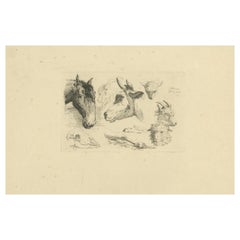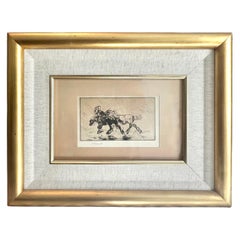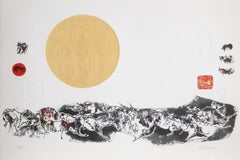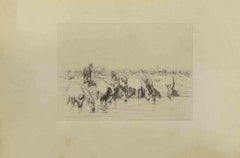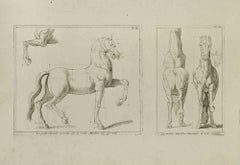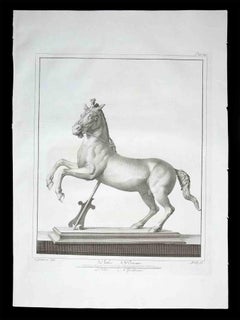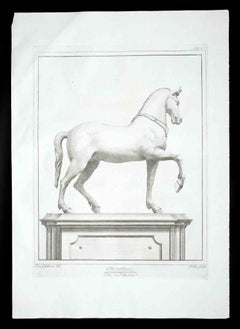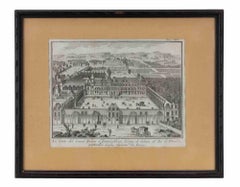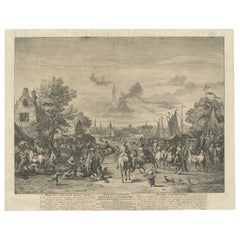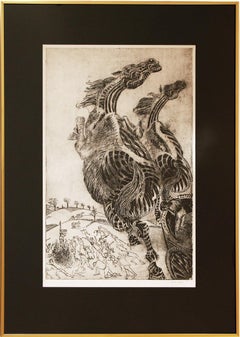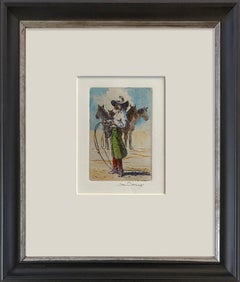Etchings Of Horses
Antique Mid-17th Century Dutch Other Prints
Paper
Antique 1810s Dutch Prints
Paper
1960s Landscape Drawings and Watercolors
Etching
20th Century English Drawings
Paper
1970s Abstract Prints and Multiples
Etching
Late 19th Century Old Masters Figurative Prints
Engraving, Etching
18th Century Modern Figurative Prints
Etching
18th Century Old Masters Figurative Prints
Etching
18th Century Old Masters Figurative Prints
Etching
1740s Contemporary Figurative Prints
Etching
Antique 1720s Maps
1950s Modern Animal Prints
Paper, Etching
1960s Abstract Prints and Multiples
Etching, Lithograph
21st Century and Contemporary Contemporary Animal Prints
Etching, Aquatint, Screen
1730s Old Masters Landscape Prints
Watercolor, Laid Paper, Engraving, Etching, Intaglio
17th Century Old Masters Animal Drawings and Watercolors
Paper, Crayon
1970s Modern Still-life Prints
Paper, Ink, Drypoint
21st Century and Contemporary Contemporary Animal Prints
Paper, Etching
21st Century and Contemporary Photorealist More Prints
Paper, Etching
21st Century and Contemporary Photorealist Still-life Prints
Paper, Etching
21st Century and Contemporary Photorealist Animal Prints
Gold Leaf
21st Century and Contemporary Minimalist Still-life Prints
Gold Leaf
1920s American Impressionist Animal Drawings and Watercolors
Chalk
1920s American Modern Nude Drawings and Watercolors
Graphite
1940s American Modern Nude Drawings and Watercolors
Chalk
Vintage 1950s French Mid-Century Modern Collectible Jewelry
Brass
1940s American Modern Nude Drawings and Watercolors
Chalk
Recent Sales
2010s Figurative Prints
Paper, Watercolor, Etching
2010s Figurative Prints
Paper, Watercolor, Etching
1970s Surrealist Abstract Prints
Etching
Antique 17th Century Dutch Baroque Prints
Paper
Antique Mid-18th Century Drawings
Paper
Mid-17th Century Animal Prints
Etching
1760s Animal Prints
Engraving, Etching
Late 18th Century Animal Prints
Mezzotint, Etching
Early 18th Century Figurative Prints
Etching
21st Century and Contemporary Dutch Prints
21st Century and Contemporary Dutch Other Prints
21st Century and Contemporary Dutch Prints
21st Century and Contemporary Dutch Other Prints
20th Century Hungarian Modern Prints
Antique 1890s British Late Victorian Books
Paper
17th Century Dutch School Animal Prints
Etching
20th Century Unknown Victorian Drawings
Wood, Paper
Antique Late 19th Century Prints
21st Century and Contemporary Animal Prints
Gold Leaf
20th Century British Paintings
Wood, Paint, Paper
1940s American Modern Animal Prints
Paper, Etching
1970s Cubist Animal Prints
Etching, Aquatint
20th Century Surrealist Animal Prints
Etching
2010s Contemporary Animal Prints
Gold Leaf
19th Century Figurative Prints
Etching
Early 20th Century German Prints
Paper
1970s Surrealist Figurative Prints
Etching
Early 19th Century Other Art Style Animal Prints
Paper, Engraving
1970s Surrealist Prints and Multiples
Archival Paper, Etching
1930s Romantic Figurative Prints
Paper, Ink, Drypoint
20th Century Asian Mid-Century Modern Tobacco Accessories
Bronze
Late 20th Century French Signet Rings
2010s Contemporary Animal Prints
Gold Leaf
1940s American Modern Nude Drawings and Watercolors
Charcoal
2010s Figurative Prints
Etching
People Also Browsed
Antique Mid-19th Century Chinese Qing Textiles
Silk
Mid-20th Century Danish Mid-Century Modern Lounge Chairs
Lambskin, Sheepskin, Wool, Beech
21st Century and Contemporary French Other Pillows and Throws
Textile, Tapestry, Wool, Velvet, Feathers
Antique Late 19th Century Asian Table Lamps
Porcelain
Antique Early 19th Century English George IV Shelves
Brass
Antique 19th Century English Bookcases
Mahogany
2010s French Modern Chairs
Oak, Fabric
Early 20th Century French Rustic Table Lamps
Animal Skin, Wood
Vintage 1950s Italian Mid-Century Modern Carts and Bar Carts
Brass
Vintage 1910s British Hollywood Regency Models and Miniatures
Metal, Aluminum, Berlin Iron, Brass, Bronze, Cut Steel, Foil, Iron, Nick...
Early 20th Century Japanese Meiji Lacquer
Copper
20th Century American Regency Armchairs
Upholstery, Wood, Giltwood
21st Century and Contemporary Indian Vases
Brass
Antique 19th Century Japanese Edo Ceramics
Ceramic
Antique 1860s French French Provincial Pillows and Throws
Wool
Vintage 1960s American Modern Photography
Wood, Paper
Etchings Of Horses For Sale on 1stDibs
How Much are Etchings Of Horses?
- What is etching?1 Answer1stDibs ExpertSeptember 25, 2019
Etching is a method of making prints using metal plates onto which a design has been incised by acid.
- What is a Picasso etching?1 Answer1stDibs ExpertApril 5, 2022An etching is created by cutting down a metal plate with chemicals, including acid, to achieve the desired image. The metal plate is then inked and pressed onto a piece of paper. Picasso became fascinated with etchings when he moved to Paris in the early 1900s, and would go on to pioneer new techniques with etchings throughout his career. Shop a selection of Pablo Picasso pieces from some of the world’s top art dealers on 1stDibs.
- What are the types of etching?1 Answer1stDibs ExpertSeptember 25, 2019
There is dry and wet etching.
- How do you identify an etching?1 Answer1stDibs ExpertNovember 26, 2024To identify an etching, look in the corners and on the back for an artist's signature or publisher information. Cross-referencing markings with information shared on trusted online resources can allow you to determine the artist. From there, you can browse online and print catalogues of their work to find out the title and date of the etching. In terms of how to tell an etching apart from other types of prints, one telltale sign is the appearance of slightly blurry lines along the edges. Called plate marks, these lines form from the pressure exerted by the plate during the etching process. You may need a magnifying glass to spot the plate mark on a print. If you have any difficulty with the identification process, consider enlisting the help of a certified appraiser or experienced art dealer. Shop a collection of etchings on 1stDibs.
- What is vintage etching?1 Answer1stDibs ExpertApril 5, 2022Vintage etching is a term that refers to a specific type of print produced between 50 and 100 years ago. Printmakers produced etchings by carving images into a copper plate and then soaking it in an acid bath. Then, they applied ink to the plate and pressed it against paper or another material to create an image. On 1stDibs, find a collection of vintage etchings.
- What is an original etching?1 Answer1stDibs ExpertMarch 13, 2024An original etching is a print produced during the first production run of a print series. After making an etching plate, an artist will create a limited number of etchings. Collectively, these prints are the original etchings. They differ from restrike etchings made years later, sometimes after the death of the artist. On 1stDibs, shop a diverse assortment of etchings.
- What is etched glass?1 Answer1stDibs ExpertFebruary 22, 2021Etched glass is a type of decorative glass which is the result of small cuts made to the glass. The cuts, which appear white, typically form patterns or images.
- What is a Haniwa horse?1 Answer1stDibs ExpertApril 5, 2022A Haniwa horse is a horse figurine made of terracotta clay. Haniwa are terracotta figures created in ancient Japan, and one of the most well-known designs is that of a horse. Today, replicas and originals are sought after by pottery enthusiasts worldwide. On 1stDibs, you’ll find a collection of Haniwa figurines from some of the world’s top art dealers.
- What is a wood horse?1 Answer1stDibs ExpertOctober 5, 2021A wood horse is a toy horse made of wood. But it has different meanings across cultures. In Chinese culture, a wooden horse is a symbol of freedom and passion. Find a range of antique and vintage wooden toys on 1stDibs.
- What are Stone Horses?1 Answer1stDibs ExpertApril 5, 2022Stone Horses are horse models crafted by the Peter Stone Horse Company. They are handcrafted from cellulose acetate resins and are exceptionally detailed, making each model a unique piece of art. Browse 1stDibs to find a range of authentic Stone Horse models.
- 1stDibs ExpertApril 5, 2022Hermès started as an equestrian brand in 1837 making saddles. Hermès has since expanded its line to include riding blankets and saddle pads. Hermès saddles are handmade and can still be purchased directly through Hermès or authorized retailers. On 1stDibs, find a collection of authentic Hermès pieces from some of the world’s top sellers.
- What are The Terracotta Horses?1 Answer1stDibs ExpertApril 5, 2022The Terracotta Horses are horse sculptures that were part of the Terracotta Army in China. In Ancient China it was believed that horses were indispensable and essential to Chinese warfare therefore they were immortalized in terracotta form. Shop a selection of terracotta horses on 1stDibs.
- 1stDibs ExpertOctober 24, 2024To tell a lithograph from an etching, look closely along the edges of the print. Etching is a way of incising lines on a metal plate by first drawing on an acid-resistant coating, or ground, to reveal the metal beneath. Lithography uses a stone rather than a plate. As a result, etchings will usually have a faint imprint or indentation called a plate mark, while a lithograph will not. Researching the artist using trusted online resources may also be helpful, as some printmakers worked exclusively with etchings or lithographs. Find a large selection of lithographs and etchings on 1stDibs.
- Did Picasso make etchings?1 Answer1stDibs ExpertApril 5, 2022Yes, Pablo Picasso made etchings and took that foundation into an exploration of printmaking and the different methods of that medium. Picasso first began working on etchings in the early 1900s, quickly mastering the technique, and then he began expanding and pushing the boundaries to create a unique and signature style. On 1stDibs, find a variety of original artwork from top artists.
- Can I etch the back of a mirror?1 Answer1stDibs ExpertApril 5, 2022Yes, you can etch on the back of a mirror. Modern mirrors typically have a reflective layer that is deposited on the back of the glass. If you want to etch the back of a mirror you need to remove the reflective layer, which can be done with an engraving tool or with an etching solution. Shop a range of antique and modern mirrors on 1stDibs.
- 1stDibs ExpertAugust 26, 2024The difference between an etching and a print depends on how specific the terms are. Print is a general term for any type of artwork made by transferring an image onto another material, such as paper or fabric. A specific printmaking technique, etching is a way of incising lines in a metal plate by first drawing on an acid-resistant coating, or ground, to reveal the metal beneath. The plate is then submerged in acid, which “bites” the lines into the metal plate. On 1stDibs, find a large selection of etchings and other prints.
- 1stDibs ExpertOctober 15, 2024To tell if an etching is valuable, one approach is to conduct research using trusted online resources. The maker, age, image quality, historical significance and overall condition all play a role in determining the potential value of an etching. By seeing how much similar etchings have sold for in the past, you can get a rough idea of how much your piece may be worth. However, experts generally recommend having a certified appraiser or experienced art dealer evaluate prints for a more accurate valuation. Find a wide range of etchings on 1stDibs.
- 1stDibs ExpertApril 3, 2024The difference between a lithograph and an etching is that while both are types of prints, they are made using different techniques. With respect to lithography, the image to be printed is drawn or painted on a stone or metal plate with an oil-based substance, such as a greasy crayon or tusche (an oily wash). The stone is then covered with water, which is repelled by the oily areas. Oil-based ink is then applied to the wet stone, adhering only to the oily image. Afterward, the stone is covered with a sheet of paper and run through a press.
Etching is a way of incising lines in a metal plate by first drawing on an acid-resistant coating, or ground, to reveal the metal beneath. The plate is then submerged in acid, which “bites” the lines into the metal plate. The ground is then removed and the plate is inked for pressing.
Find a collection of lithographs for sale on 1stDibs. - 1stDibs ExpertAugust 29, 2024To tell if an etching is original, first gently run your hand along its surface. An original etching will usually have a slight indentation in the image area left behind by the pressure applied by the plate during the printing process. Next, grab a magnifying glass and view the image up close. On an original, you won't see small dots making up the picture, but many reproductions do display dots due to their printing methods. Finally, look at the signature. Most original etchings will be hand-signed. If the signature is printed on your piece, it may be a reproduction. Consult a certified appraiser or experienced art dealer for an expert opinion on your print. Find a wide variety of etchings on 1stDibs.
- 1stDibs ExpertAugust 26, 2024The difference between etching and aquatint is technique. Invented in the 1500s, etching is a way of incising lines in a metal plate by first drawing on an acid-resistant coating, or ground, to reveal the metal beneath. The plate is then submerged in acid, which “bites” the lines into the metal plate. The ground is then removed, and the plate is inked for pressing. Etched lines tend to reveal the movement of the artist’s hand more than a technique like engraving, since the image is created on softer ground. Aquatint, a technique named for its resemblance to watercolor or ink wash, is often combined with etching to create rich tonal variations. It’s a similar process to etching, but the resin ground is more granulated, so the acid handles the metal differently. Different degrees of darkness are created based on the amount of time the plate is in contact with the acid. Find a collection of etchings and aquatint prints on 1stDibs.

